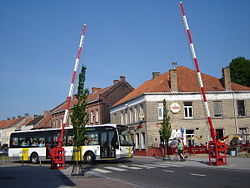Ghistelles
| Gistel | |||
|---|---|---|---|
| Municipality | |||
 |
|||
|
|||
| Location in Belgium | |||
| Coordinates: 51°09′N 02°58′E / 51.150°N 2.967°ECoordinates: 51°09′N 02°58′E / 51.150°N 2.967°E | |||
| Country | Belgium | ||
| Community | Flemish Community | ||
| Region | Flemish Region | ||
| Province | West Flanders | ||
| Arrondissement | Ostend | ||
| Government | |||
| • Mayor | Bart Halewyck (CD&V) | ||
| • Governing party/ies | CD&V, N-VA, sp-a | ||
| Area | |||
| • Total | 42.25 km2 (16.31 sq mi) | ||
| Population (1 January 2016) | |||
| • Total | 11,851 | ||
| • Density | 280/km2 (730/sq mi) | ||
| Postal codes | 8470 | ||
| Area codes | 059 | ||
| Website | www.gistel.be | ||
Gistel is a municipality located in the Belgian province of West Flanders.
Following local government boundary reforms in 1971 and 1977, the municipality has comprised not only Gistel, but also the towns of Moere, Snaaskerke and Zevekote.
On January 1, 2006 the Gistel municipality had a total registered population of 11,125, of whom more than 8,000 were in Gistel itself. The total area is 42.25 km² which gives a population density of 263 inhabitants per km². The German town of Büdingen is its twin town.
The most famous inhabitant of Gistel was Sylvère Maes, winner of the Tour de France in 1936 and 1939.
Another former resident of Gistel is Johan Museeuw, also famous cyclist, but now retired. He won Paris–Roubaix three times.
In 2011, a museum opened in Gistel, in honor of Maes and Museeuw.
The present mayor, Bart Halewyck, was the first hacker ever convicted in Belgium after the 'Bistel Trial' in 1990. He was already alderman and had to resign after his conviction.
Administration Centre
Church of Our Lady (Onze Lieve Vrouw)
Gistel is the origin of the veneration of Saint Godelieve
Oostmolen windmill in full sail
...
Wikipedia




